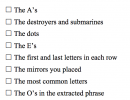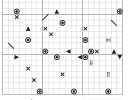Me and Mirek got really lucky when we were offered to join The Usual Suspects team for this year’s Microsoft Puzzle Hunt. We finished third and got Gold Record for it because the theme was music (teams that finished before us got Platinum and Diamond). The hunt was in many aspects different from Czech puzzle events…
First, let’s get the terminology right. In Czech we have “šifrovačka” and that’s it. In the US people distinguish between hunts and games. Hunts are parallel (think Sendvič, InterLOS or Puzzled Pint) and as a result they are often internet based or limited to a small area (Microsoft campus, MIT campus). Games are linear and people have to walk or drive from one puzzle location to another. That means TMOU does not qualify as a puzzle hunt.
That being said, it is no surprise that Microsoft Puzzle Hunt is highly parallelised event. Maximum team size is 12 people, teams with less than 8 people are recommended to merge with other teams. This year there were 70 teams in total. Each team needs at least 3 Microsoft employees who have badges to access all the buildings. Microsoft campus is huge, it has more than 80 different buildings on an area roughly 1.5 x 2.5 kilometers.
The campus has a huge potential that remained unused this year. Our team had a big conference room reserved for the whole hunt (actually three adjacent conference rooms but we mostly used just one of them) to serve as our headquarters. At the very beginning, we had to send a few people to the opening ceremony. Later, we had to send a few people to drive around campus to collect information for one puzzle. Other than that, it was 12 people sitting in single room the whole time, solving puzzles that were available online. I feel like if the organisers did not insist on 3 Microsoft employees they could have turned it into an online hunt open for anyone on the world.
I was really worried about the length of the hunt. It starts on Saturday at 10am and ends on Sunday at 5pm which would make it the longest hunt I have ever done. Not knowing when we would finish, we brought sleeping bags and pillows (just in case), a lot of food, laptops and pretty much everything that could be handy. It was a lot of stuff, especially when compared to small backpacks people usually carry for Czech puzzle games. We also ordered Saturday lunch and dinner for the whole team in nearby restaurants that someone picked up and brought to our headquarters at the right time. What a luxury! It turned out we were overprepared as we finished the hunt before midnight, after 13.5 hours of the game with 17.5 hours still left.
The way this hunt was prepared was really interesting. Originally, the idea was that people from winning team would take over the organisation. A few years back there were no people from top teams willing to prepare the whole hunt (usually 60 puzzles), so they decided to make it modular. Each module, consisting of 5 to 12 puzzles, was prepared by someone else and there was a small group of people who put the modules together. People who made the puzzles for one module were allowed to play, avoiding puzzles from their module. This year everyone wanted to play and no one was willing to look at all puzzles to put them together so no one did! They basically turned the hunt into 10 independent hunts. This has a lot of drawbacks (risk of duplicates or similarities, lack of specific puzzle types, no connections or references outside of module) but supposedly it was the only way to make it happen.
So what did the puzzles look like? In Czech we talk about transposition, substitution, graphic, steganography and other (typically associations or playing around with words). We have not invented a large vocabulary for describing what the puzzle is. If you look at basic puzzle types on Microsoft Puzzle Hunt website, you will find 14 of them. When you see a Czech puzzle, you usually have no idea what it is until you spend some time analysing it. When you see an American puzzle, you either know what it is or there is a text telling you. Do you like spoonerisms, cryptic crosswords or drop quotes? Just quickly skim through the puzzles and pick the one that has it. Some of the puzzles we solved would not be considered puzzles because they have known rules – sudoku, slitherlink, nurikabe.
Another difference is in the “correctness” of the puzzle. They take it to a whole different (maybe even boring) level here. Each puzzle has a footer that tells you whether you need to print it in color or whether black and white is ok. It would also tell you in case you needed non-standard paper size. And it has the author of the puzzle which to me seems like a huge hint if you know the person and you know what kind of puzzles s/he makes. There are famous authors whose puzzles are almost fought over within the team while puzzles from unknown authors wait in a line. There are also meta puzzles. You know that a puzzle is meta because it is called meta. And there are rules for solving metas. You need to solve most of the puzzles in the module and when you know the answers you somehow plug them in the meta and then you solve it. Remember all the hours spent by trying to figure out what the puzzle is and what else you need to solve it? They are all gone; no paranoia here.
If you are from the Czech Republic you might begin to think the puzzles in the US must be boring. Even though I think they are slightly less entertaining because of all the known rules, extra information and correctness, there were some amazing puzzles. One of the modules was called Adele 21. All the puzzles in the module worked with 21×21 grid even though you may not have noticed that (for example having 11 lines of text with double spacing gives you 21 lines). The meta puzzle told you which “squares” to extract from each puzzle once you have solved it (for example take all letters X). If you colored all of those squares you got a QR code with the solution.
There were also some puzzles that I would have enjoyed in Czech but that were impossible for me to solve in English. Food spoonerisms were awesome: stomach pants > belly jeans > jelly beans, policeman smut > cop porn > pop corn. English is also interesting because it often works with sounds rather than letters. You can take chip+monk and make it a chipmunk and no one cares that you have just changed o to u. You can also use knight and night interchangeably which comes handy for example when working with pictures.
Due to the differences described above, there were two “types” of puzzles missing. First, puzzles that take hours to solve. On almost every overnight hunt there is a puzzle or two that take literally hours to solve even though you have 5 people focusing on them full time. I do not think there was such a puzzle here. Second, there were no text puzzles. By text puzzle I mean a text that describes itself, text with slight hints that you have to interpret in a right way, text where you need to notice there is exactly one noun in each sentence, or there is one usual letter missing, text that seems to be talking about one thing but actually describing something else. Maybe it is actually just “type” of puzzle I was missing and that is puzzle without instructions, puzzle where the steps you need to take are very unclear.
The last observation I am going to mention is about the players. I would say that in the Czech Republic there is this (mostly correct) stereotype about the nerdy Math students being the people participating in puzzle activities. It is true that most of the people are in their twenties or thirties and a lot of people are still university students; only in the last few years there has been a boom of teams with babies in strollers. I am really bad at judging age but my guess would be that the community here is at least ten years older, maybe even more. My theory is that in the Czech Republic it is not unusual to play 5-10 overnight games every year which requires a lot of free time and therefore it is suitable for students and people without commitments. Here the amount of puzzle hunts and games is much lower; I have only talked to a few people but they all play up to three times per year. It makes me wonder what is the Czech puzzle community going to look like in 10+ years…









